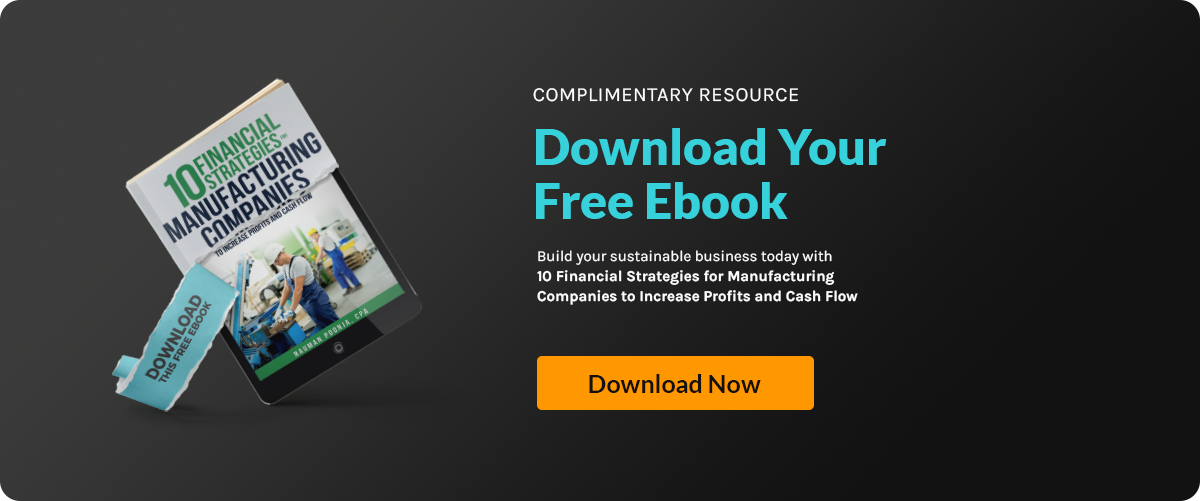Raising capital is a natural part of growing any manufacturing company. Whether you're buying new...
The Small Business Guide to Budgeting Smarter and Preventing Costly Errors

Budgeting is one of the most powerful financial tools available to a business owner. Yet many small businesses either create budgets they never use, treat them as one-time tasks, or ignore them altogether. When a budget is poorly constructed or inconsistently followed, it leads to cash shortages, stalled growth, and profit margins that slip without warning.
For manufacturing companies and growing small businesses, budgeting is not just about planning next month’s expenses. A good budget aligns your production capacity, sales expectations, staffing needs, equipment planning, and cash flow. It tells your leadership team how the business is performing and where adjustments are needed to protect profitability.
This guide explains the common budgeting mistakes that small businesses make, why they happen, and how to avoid them. By improving your budgeting discipline, you strengthen financial control, improve decision-making, and build long-term sustainability.
Why Budgeting Matters More Than Many Founders Realize
Budgets are not just spreadsheets. They are communication tools.
A well-structured budget:
- Sets financial expectations for the business
- Allows leaders to evaluate performance consistently
- Helps prevent overspending and margin erosion
- Makes cash flow predictable instead of surprising
- Supports growth planning and investment decisions
Without a budget, it becomes difficult to understand whether your profit levels are healthy, whether costs are rising too quickly, or whether production output is aligned with demand. Many founders only discover financial problems when cash runs low. A proactive budget prevents that.
A disciplined budget also aligns well with the broader financial management control process, helping leaders turn performance data into rapid, informed action.
Mistake #1: Treating the Budget as a One-Time Task
Many businesses create a budget at the beginning of the year and then never look at it again. A budget must be reviewed continuously to remain useful. Demand changes, supplier pricing shifts, labor needs fluctuate, and economic conditions evolve.
The best practice: Conduct a monthly review comparing:
- Actual revenue vs. budgeted revenue
- Actual expenses vs. budgeted expenses
- Margin shifts and their causes
This approach gives you insight into operational performance and prevents you from reacting too late when something changes.
Mistake #2: Ignoring Cash Flow Timing
Revenue and profit are not the same as cash. A business can appear profitable on paper and still struggle to cover payroll or vendor payments if cash timing is poorly understood.
Small businesses often overlook the importance of cash flow forecasting, which helps predict when cash will be available and when it will be strained. If you sell to customers on credit terms or have long production cycles, understanding how cash moves is essential. Guidance from tools like cash flow forecasting becomes critical to preventing cash shortages.
Mistake #3: Underestimating Expenses
One of the most common budgeting errors is underestimating expenses, especially variable and hidden costs. This includes:
- Shipping, freight, and fuel costs
- Equipment maintenance
- Software subscriptions
- Repairs and unplanned downtime
- Seasonal labor increases
Manufacturers should revisit their margin analysis regularly to ensure that cost assumptions remain accurate. Under-budgeting on expenses leads directly to lower profit and sometimes negative cash flow.

Mistake #4: Forgetting to Budget for Growth
Growth requires investment. Businesses often budget based on current operations but forget to include costs required to scale, such as:
- Additional equipment
- New hires
- Training and onboarding
- Increased raw materials and inventory
- Facility expansion or leasing
This is where capacity and production planning becomes important, ensuring that production can scale without creating bottlenecks or inefficiencies.
Mistake #5: Not Using Budgets to Set Real KPIs
Budgets only work when tied to measurable performance targets. Many founders skip this step and end up with a budget that functions like a static document rather than a management tool.
Budgets should be connected to financial KPIs to evaluate whether the business is improving. For manufacturers, this may include tracking cost of goods sold, operating margin, labor efficiency, and production throughput.
When KPIs are aligned with budget expectations, teams understand what success looks like and how performance will be evaluated.
Mistake #6: Not Separating Fixed and Variable Costs
Businesses that lump all costs together miss a critical source of insight. Not all costs behave the same way. Fixed costs remain steady regardless of output, while variable costs change with production volume.
| Cost Type | Examples | Impact on Budget |
|---|---|---|
| Fixed Costs | Rent, insurance, salaried staff, software systems | Predictable, helps stabilize forecasts |
| Variable Costs | Raw materials, hourly wages, shipping, utilities | Must be monitored closely as operations scale |
Understanding the difference improves pricing strategy and margin protection. It also supports more accurate contribution margin analysis.
Mistake #7: Failing to Reforecast During the Year
A budget cannot predict everything. Supplier pricing changes. Customer demand shifts. Equipment breaks down. Wages increase. A reforecast updates the budget with new information so your financial plan stays realistic.
The most agile businesses use rolling forecasting to adapt quickly and stay aligned with real-world conditions.
Mistake #8: Relying Only on the Profit and Loss Statement
Many small businesses make the mistake of budgeting solely from the Profit and Loss (P&L) statement. While the P&L shows profitability, it does not show:
- Cash availability
- Asset value changes
- Debt obligations
- Inventory movement
Strong budgeting considers:
- The balance sheet
- The cash flow statement
- Operational production data
This ensures a complete understanding of financial health.
Mistake #9: Failing to Involve Key Team Members
If only the founder or accountant builds the budget, the budget lacks operational detail. Team members closest to production, logistics, sales, and inventory control offer insights that improve accuracy.
When department leaders participate in the budgeting process, they are more likely to follow it and take accountability for performance.
Mistake #10: Not Revisiting Vendor and Supplier Contracts
Many businesses treat vendor pricing as fixed when it is often negotiable. Reviewing contracts annually can lead to meaningful cost savings. This may include:
- Renegotiating freight terms
- Consolidating suppliers
- Seeking volume purchase discounts
- Adjusting payment schedules
Cost optimization is a core part of strengthening financial sustainability. For manufacturing environments, this aligns with broader strategies to improve inventory efficiency through cost optimization.
A Smarter Way to Budget: Start with Reality, Then Improve
A strong budget doesn’t predict the future perfectly—it helps you understand what to do when reality shifts. That means:
- Start with accurate historical data.
- Build assumptions based on real operating patterns.
- Review results monthly.
- Reforecast as conditions change.
- Use KPIs to measure progress.
Budgeting does not need to be complicated. It needs to be consistent, reviewed, and aligned with operational goals.
Want a budget that actually supports growth—not just paperwork?
Contact Accounovation to build budgeting systems that improve decision-making, protect profit, and strengthen financial control.






